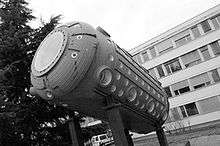Gargamelle

Gargamelle was a giant bubble chamber detector at CERN, designed mainly for the detection of neutrino interactions. Built in France, with a diameter of nearly 2 meters and 4.8 meters in length, Gargamelle held nearly 12 cubic meters of Halon 1301 (CF3Br). The usage of a heavy liquid, rather than the more typical liquid hydrogen, meant higher neutrino interaction probability, as well as easier identification of muons versus pions.
The conception and construction of giant bubble chambers such as Gargamelle and BEBC was based on the knowledge acquired through the construction and operation of the 30 cm hydrogen chamber, which came into operation at CERN in 1960, and followed four years later by the 2 m hydrogen chamber.[1]
Gargamelle operated from 1970 to 1978 with a muon neutrino beam produced by the CERN Proton Synchrotron. These experiments led to one of the most important discoveries ever made at CERN: the experimental observation of the weak neutral currents was announced in July 1973,[2] shortly after their theoretical prediction.
For the experiment, approximately 83,000 neutrino events were analysed, and 102 neutral current events observed. The signature of a neutral current event was an isolated vertex from which only hadrons were produced.
The name of the chamber derives from the giantess Gargamelle in the works of François Rabelais; she was Gargantua's mother.
References
- ↑ Wenninger, Horst. "In the tracks of the bubble chamber" (PDF). CERN Courier. CERN. 44 (6): 26–29.
- ↑ http://public.web.cern.ch/public/en/About/History73-en.html
- The discovery of the weak neutral currents, CERN Courier
- Experimental Study of the High-energy Reactions Anti-muon-neutrino e → Antu-muon-neutrino e-, Anti-muon-neutrino N → mu + X in the Gargamelle Bubble Chamber. (In French) Farhad Rahimi (Strasbourg, CRN). CRN-HE-84-13, Dec 1982.
- The road to unification – Gargamelle and the discovery of Weak Neutral Currents
External links
- Padilla, Antonio (Tony). "Gargamelle and Neutral Currents". Sixty Symbols. Brady Haran for the University of Nottingham.
| Wikimedia Commons has media related to Gargamelle. |
Categories:Particle detectors